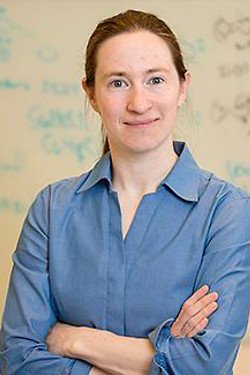Recognized for: Innovations in catalytic C-H functionalization and development of novel synthetic methodology that provide chemists the ability to access molecules of varying complexity. These molecules find applications in multiple arenas including the agrochemical, pharmaceutical and medical imaging industries.
Areas of Research Interest and Expertise: C-H Functionalization, Transition Metal Catalysis; Fluorination Chemistry and Radiofluorination; Organometallics, New Materials for Non-aqueous Flow Batteries
Bio:
Ph.D., Chemistry, California Institute of Technology
B.S., M.S., Chemistry, Yale University
Prof. Sanford’s research spans the fields of organic and inorganic chemistry. She is an international leader in the development and study of transition metal catalyzed reactions that are widely applied in the chemistry industry for the efficient construction of new pharmaceuticals and agrochemicals. Prof. Sanford has also pioneered a tandem catalysis approach for carbon dioxide capture and conversion, and has made important discoveries in the design of energy storage materials for applications in redox flow batteries. Furthermore, she has developed new carbon-fluorine bond forming reactions for accessing important brain and heart imaging agents. Throughout her work, Prof. Sanford uses rigorous mechanistic analysis to develop novel transformations and catalysts.
Quote:My research focuses on the design, development, and study of new chemical reactions, aiming to reduce complexity and decrease the environmental impact of making functional molecules. We then use these molecules for applications including the treatment of disease, biomedical imaging, battery materials, and carbon dioxide recycling.
Key Publications:
- Sevov, C. S.; Hickey, D. P.; Cook, M. E.; Robinson, S. G.; Barnett, S.; Minteer, S. D.; Sigman, M. S.; Sanford, M. S. “APhysicalOrganicApproachtoPersistent, Cyclable, Low-PotentialElectrolytesforFlowBatteryApplications,” J. Am. Chem. Soc.2017, 139, 2924-2927.
- Topczewski, J. J.; Cabrera, P. J.; Saper, N. I.; Sanford, M. S. “Palladium-Catalysed Transannular C–H Functionalisation of Alicyclic Amines,” Nature2016, 531, 220-224.
- Rezayee, N. M.; Huff, C. A.; Sanford, M. S. “Tandem Amine and Ru Catalyzed Hydrogenation of CO2 to Methanol,” J. Am. Chem. Soc.2015, 137, 1028-1031.
Hickman, A. J.; Sanford, M. S. “High Valent Copper and Palladium in Catalysis,” Nature 2012, 484, 177-185. - Lyons, T. W.; Sanford, M. S. “Palladium-Catalyzed Ligand-Directed C–H Functionalization Reactions,” Chem. Rev. 2010, 110, 1147-1169.
Other Honors:
2016 Elected Fellow, American Chemical Society
2016 Elected Member, National Academy of Sciences
2016 Elected Fellow, American Academy o Arts and Sciences
2015 OMCOS Award
2013 Raymond and Beverly Sackler Prize in Chemistry
2011 MacArthur Foundation Fellowship
2011 Fellow of American Association for Advancement of Science
2011 ACS Award in Pure Chemitsry
2010 National Fresenius Award
2008 ACS Arthur C. Cope Scholar Award
2006 Presidential Early Career Award for Scientists and Engineers
2006 National Science Foundation CAREER Award
2004 Beckman Young Investigator Award
2003 Camille and Henry Dreyfus Foundation New Faculty Award
In the Media:
In situ with Melanie Sanford, Chemistry World, May 26, 2017
Sanford Honored with Election to National Academy of Sciences, LSA Chemistry, University of Michigan, May 4, 2016
Melanie Sanford - Better Ways to Make Molecules, Youtube, May 5, 2017
Melanie Sanford: The Interview, Science Magazine, November 24, 2006
The Sanford Group
